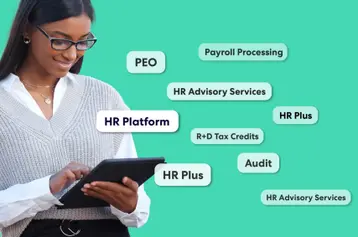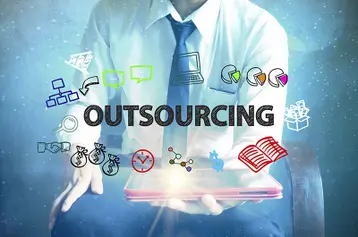Unlock Your Business Potential with PEO ROI Insights

Table of contents
- 1.Possible ROI for PEOs
- 2.How to Calculate ROI for a PEO
- 3.How a PEO Can Boost ROI
- 4.Cost optimization
- 5.Stronger employee retention
- 6.Higher rates of growth
- 7.Workers' compensation
- 8.Enhanced productivity
- 9.Compliance support
- 10.Solutions for a global workforce and independent contractors
- 11.Getting a Great PEO ROI
A professional employer organization (PEO) provides human resources services to companies that want to outsource their HR administrative functions. PEOs often work with small and medium-sized businesses. They help these companies with HR tasks with greater efficiency and accuracy, such as payroll, administering payroll taxes, providing best practice guidance on compliance, and helping with risk mitigation. A PEO and a client company form a co-employment relationship, where responsibilities of each party are allocated pursuant to a client service agreement.
Working with a PEO also enables small and mid-sized companies to give their employees access to big-company benefit plans, attract and retain top talent, and free up their leaders' time and attention to focus on growing the business.
Possible ROI for PEOs
Working with a PEO can provide small and medium-sized businesses with a notable return on investment (ROI). According to the National Association of Professional Employer Organizations (NAPEO), the estimated average PEO ROI is 27.2% just on cost savings alone. This comes out to an estimated potential average cost savings (in 2019 dollars) of $1,775 per employee per year.
Based on NAPEO’s report, more than half of those savings (54%) come from companies saving money on salaries and benefits for internal HR staff. The next largest source of savings (37%) stemmed from health benefits costs. Other savings were from lower workers’ compensation and unemployment insurance costs, as well as other HR expenses.
How to Calculate ROI for a PEO
Your ROI for using a PEO can be expressed in a formula. Calculate the amount you save by working with a PEO. Subtract your costs of the PEO fees. Divide the result by the costs. For example, if you save $1,270 by using a PEO, and your PEO fees are $1,000, you calculate your ROI by computing (1,270 - 1,000) / 1,000. The result of this cost-benefit analysis is that your ROI equals 27%.
While the formula itself is straightforward, there are many separate metrics involved in calculating or estimating your current HR costs and expected savings. TriNet makes it easier by providing an ROI estimate calculator that takes you through the process one step at a time. You just answer the prompts, and the estimate calculator will do the rest of the work.
How a PEO Can Boost ROI
A PEO provides many services to small and medium-sized businesses that contribute to boosting their clients’ ROI and possibly their profit margins. These include:
Cost optimization
Small and mid-sized companies that try to handle their HR tasks on their own will have to pay meaningful amounts to attract, hire, and retain skilled HR employees. By outsourcing HR administrative tasks to a PEO, companies can ease the demand on their internal resources and potentially reduce expenses related to office space, software, equipment, taxes and other costs associated with running an in-house department.
A PEO may work with many client companies supporting hundreds of thousands of worksite employees. That means they enjoy economies of scale. They can access specialized experts and software that may be difficult for a small or medium company to obtain them independently.
For example, PEOs employ teams of HR professionals with a high level of specialized skills in different areas of expertise. These professionals are available for ongoing support. Trying to hire in-house people who have a similar range of expertise could be prohibitively expensive for a smaller company.
PEOs use powerful and up-to-date technology to process payroll and handle other automated tasks. This can make their processes more efficient and cost effective than would be the case for a company that uses less robust software or that still does some tasks by hand. Also, when you contract with a PEO, payroll services are usually included as an overall package with the HR outsourcing costs.
Stronger employee retention
Employee turnover can be very expensive for a company. When you lose an employee, you have to pay the expenses for recruiting, hiring, onboarding, and training a new one. You lose the experience and institutional knowledge that the former employee had. Working with a PEO can help with stronger employee retention. According to the NAPEO, companies that work with PEOs had almost 20 percentage points lower employee turnover than companies nationwide.
Several things can contribute to employee satisfaction in companies that work with a PEO:
- Access to big-company benefits. Because a PEO enjoys economies of scale, it can provide access to benefit plans that are normally offered by large companies. That enables you to offer your employees big company benefits that is cost effective. Popular employee benefits that PEOs can provide access to include medical, retirement plan, and life insurance.
- Employee engagement. Working with a PEO can provide your employees with a streamlined way to interact with HR. Self-service employee portals let workers access the system at any time to check on their pay and benefits, get information on plans, and update their information. Mobile apps and other user-friendly systems can save employees time and help reduce frustration.
- Career growth. PEOs can help your employees access training and optimize goal setting and the performance review process. A PEO typically offers talent management tools designed to help you strengthen your employee’s potential performance.
- Total compensation statement. A PEO can help you reinforce your company’s investment in your employees through a total compensation statement. This personalized report shows the total compensation of an employee’s pay package, including salary, health benefits, income protection, and retirement benefits. It shows your company’s contribution to each of these categories, reinforcing the message that you value them.This article may contain hyperlinks to websites operated by parties other than TriNet. Such hyperlinks are provided for reference only. TriNet does not control such web sites and is not responsible for their content. Inclusion of such hyperlinks in this article does not necessarily imply any endorsement of the material or association with their operators.
Higher rates of growth
NAPEO found significantly higher rates of growth in companies that work with a PEO compared to those that did not. An NAPEO study found that the annual rate of business revenue growth was 5 percentage points higher for PEO clients than for non-PEO clients. The growth rate for the number of employees was also higher (4.2 percentage points) for PEO clients.
Workers' compensation
NAPEO found that companies saved an average of $66 in workers’ compensation costs per full-time-equivalent employee.
Enhanced productivity
For a small or medium-sized company, doing HR tasks in-house can be a substantial administrative burden. By outsourcing to a PEO, employees can refocus their attention on the company’s core goals. This has two advantages: it can boost employee engagement by freeing workers from mundane, repetitive tasks, and it can enhance productivity by enabling companies to use their employees’ talents to advance the company’s business strategy.
A PEO can also provide you with data analytics that may help with profitability and give your company a competitive edge. A PEO’s powerful software can provide valuable data metrics to use for strategic planning, including market analysis, asset management, capital allocation, and workforce analytics. In addition, tools for portfolio management can help increase your financial performance.
Compliance support
Every company that has employees is probably subject to countless federal, state, and local employment-related rules and requirements. It takes a lot of resources to be aware of all the applicable rules that a company needs to follow, especially when the rules change, as they frequently do. For example, do you know how to administer leap year payroll? With the expertise of a PEO, a company does not have to spend resources on searching for compliance expertise. PEOs provide best practice guidance to help companies navigate compliance, potentially reducing the risk of costly fees and penalties.
Expert best practice guidance in just one workers' compensation claim or employment-related claim could potentially provide a tremendous return on investment.
Solutions for a global workforce and independent contractors
If you are one of the many companies that has expanded beyond the U.S. or counts on independent contractors, a PEO can provide solutions to support. It may work with lobal workforce partners that you can engage to help you with global hiring, payroll, and workforce management. Their global workforce partner can help you avoid costly missteps and think less about operational complexities while thinking more about business growth and innovation. Additionally, a PEO may offer a system to help you pay your independent contractors.
Getting a Great PEO ROI
If you are thinking about outsourcing your HR, learn more about your options from TriNet's free eguide — Finding the Best Value in an Outsourced HR Solution.
TriNet provides a comprehensive solution for your HR outsourcing needs. Its advanced HR platform streamlines HR tasks, processing them smoothly, economically, and with precision. Our tools will help you enhance your operational efficiency and optimize the economic value of your employees and other assets.
Enjoy the cost efficiency of having TriNet’s powerful technology help handle your administrative tasks. At the same time, gain access to the personalized services provided by our HR professionals.
This communication is for informational purposes only, is not legal, tax or accounting advice, and is not an offer to sell, buy or procure insurance.
This article is for informational purposes only, is not legal, tax or accounting advice, and is not an offer to sell, buy or procure insurance. It may contain links to third-party sites or information for reference only. Inclusion does not imply TriNet’s endorsement of or responsibility for third-party content.

TriNet Team
Table of contents
- 1.Possible ROI for PEOs
- 2.How to Calculate ROI for a PEO
- 3.How a PEO Can Boost ROI
- 4.Cost optimization
- 5.Stronger employee retention
- 6.Higher rates of growth
- 7.Workers' compensation
- 8.Enhanced productivity
- 9.Compliance support
- 10.Solutions for a global workforce and independent contractors
- 11.Getting a Great PEO ROI






